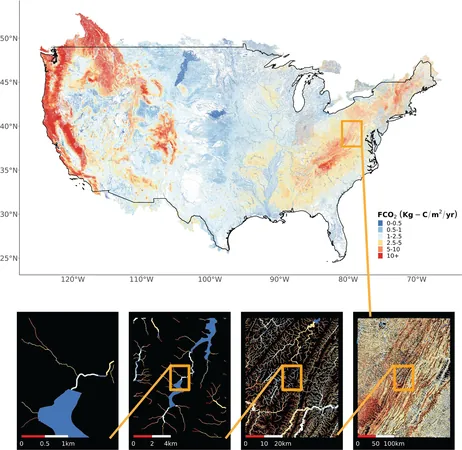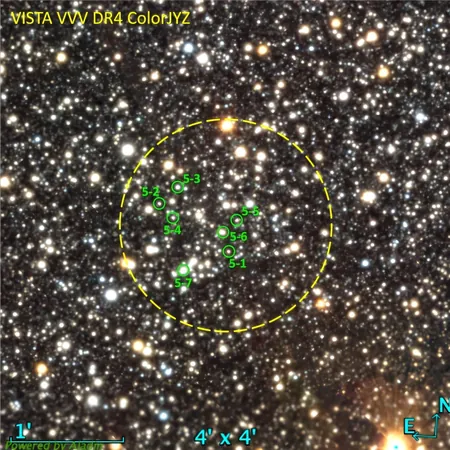
Revolutionary Research Reveals Surprising Insights into Carbon Emissions from U.S. Waterways!
2024-11-04
Author: William
Groundbreaking Study Unveils Novel Modeling Technique
In a groundbreaking study, researchers from the University of Massachusetts Amherst have unveiled a novel modeling technique that estimates carbon dioxide emissions from an astonishing 22 million lakes, rivers, and reservoirs in the United States. This innovative approach marks a significant advance in environmental science, as it is the first of its kind to be applied on a continental scale, revealing that previous calculations may have exaggerated CO2 emissions by as much as 25%!
Understanding Carbon Dioxide Emissions
The analysis indicates that carbon dioxide is produced in rivers, lakes, and streams primarily through the degradation of organic matter. When the concentration of CO2 is higher in the water than in the atmosphere, those water bodies "breathe" out the excess carbon as gas. However, determining the precise amount of CO2 and the sources contributing to it has been a complex challenge for scientists.
Importance of Accurate CO2 Measurements
As Matthew Winnick, assistant professor of Earth, Geographic and Climate Sciences and lead author of the study published in AGU Advances, emphasizes, "Understanding the amount of CO2 being generated is crucial for predicting how it will react to climate change." Rising temperatures are expected to alter the natural carbon cycle and could exacerbate the effects of climate change, making accurate emissions data essential.
Limitations of Traditional CO2 Estimates
Traditionally, CO2 estimates were derived by averaging stream concentrations over large areas, leading to generalized results that overlooked significant variations across different ecosystems. "Turbulent streams release CO2 much more quickly," explains Winnick. Additionally, smaller headwater streams receive more carbon from groundwater, which influences emissions downstream.
Development of an Alternative Model
Winnick and his colleagues developed an alternative model that examines carbon dynamics in each individual stream reach. With the help of former graduate student Brian Saccardi and civil and environmental engineering experts, they successfully applied their model across the extensive network of U.S. water bodies.
Initial Findings from Colorado
Initial tests conducted in Colorado’s East River watershed demonstrated the effectiveness of their method, which boasts a dramatic reduction in estimated carbon emissions. Their findings revealed an estimated 120 million metric tons of carbon emissions — a stark contrast to the previous average of 159 million metric tons, showcasing the importance of mountainous regions in continental CO2 emissions.
Implications for Carbon Sequestration Initiatives
This newly refined understanding of carbon emissions has far-reaching implications for carbon sequestration initiatives. By enhancing techniques like adding calcium carbonate minerals to streams—aimed at stabilizing CO2—the research hopes to fine-tune these approaches. "To determine whether these methods are effective, we must measure the CO2 levels dynamically along river systems," Winnick states. Given that CO2 concentrations can fluctuate dramatically within short distances, being able to forecast these changes is vital for assessing effective carbon mitigation strategies.
Debates on CO2 Emission Sources
Moreover, an ongoing debate in the field centers on the origin of the CO2 emissions: is it sourced from groundwater or directly from stream corridors? To accurately predict the response of carbon emissions to climate change, scientists must unravel this critical question, as each environment reacts differently to climatic variations.
Warnings from the Research
"If CO2 originates from near-stream sediment, where the water exchanges with underground systems, its reactions to temperature and precipitation changes will differ from those in hillside groundwater," warns Winnick. This research is not just number-crunching; it could reshape our understanding of carbon cycling and our response to climate change.
Conclusion and Future Implications
As scientists continue to probe these mysteries, the new methodologies developed by the UMass Amherst team hold the promise of revolutionizing how we comprehend and respond to carbon emissions in our waterways. The implications of this research could impact environmental policy, conservation strategies, and ultimately, the fight against climate change! Stay tuned for more updates on this vital research that challenges previous conclusions and reshapes our understanding of our planet's carbon cycle!









 Brasil (PT)
Brasil (PT)
 Canada (EN)
Canada (EN)
 Chile (ES)
Chile (ES)
 España (ES)
España (ES)
 France (FR)
France (FR)
 Hong Kong (EN)
Hong Kong (EN)
 Italia (IT)
Italia (IT)
 日本 (JA)
日本 (JA)
 Magyarország (HU)
Magyarország (HU)
 Norge (NO)
Norge (NO)
 Polska (PL)
Polska (PL)
 Schweiz (DE)
Schweiz (DE)
 Singapore (EN)
Singapore (EN)
 Sverige (SV)
Sverige (SV)
 Suomi (FI)
Suomi (FI)
 Türkiye (TR)
Türkiye (TR)